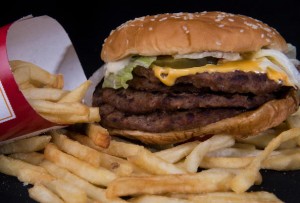Fast Food and Food Deserts

Paul J. Richards / Getty Images
This Burger King hamburger has 1,010 calories and the fries have 500 calories.
Many of the tactics cited to fight food deserts focuses on encouraging supermarkets to open in neighborhoods where there aren’t many. But a new study shows that simply bringing in a grocer doesn’t translate into healthier eating habits.
The Archives of Internal Medicine published the study, which shows that having more grocery stores in neighborhoods didn’t have much of an impact on how many fruits and vegetables people ate. The study does, however, find another link between income and fast food, reports Reuters Health:
For low-income men in the study, living close to lots of fast-food restaurants meant they ate at those restaurants more often — but there was only a weak link for middle-income people, and no clear link for those with the highest incomes…
[Researchers] say policymakers’ attempts to get new supermarkets into poor urban neighborhoods might not be enough to change the tide of obesity, diabetes and other health problems common in those areas.
“We’re talking about a top-to-bottom approach that would be important,” [study author Penny] Gordon-Larsen said. That would include educating people in the community and inside those supermarkets and grocery stores, organizing the stores to promote more healthy food options and giving incentives to make healthy food cheaper than less-healthy alternatives, she said.
According to the U.S. Department of Agriculture, D.C. has seven food deserts. But the USDA definition of a food desert only applies to low-income areas with limited access to supermarkets or grocery stores. Perhaps a new category is needed to define low-income areas with an abundance of fast food options.
-
Steven Swann
-
http://twitter.com/razibkhan Razib Khan
-
Anonymous
-
Anonymous





